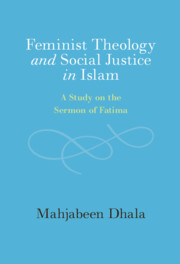22 results
De jure and de facto inclusivity in global governance
-
- Journal:
- Review of International Studies , First View
- Published online by Cambridge University Press:
- 26 September 2024, pp. 1-25
-
- Article
-
- You have access
- Open access
- HTML
- Export citation
When the House is Not a Home: Assessing the Family-Friendliness of Canadian Legislatures
-
- Journal:
- Canadian Journal of Political Science/Revue canadienne de science politique / Volume 57 / Issue 2 / June 2024
- Published online by Cambridge University Press:
- 22 September 2024, pp. 278-300
-
- Article
-
- You have access
- Open access
- HTML
- Export citation
Chapter 5 - Subsidised Theatre
- from Part II - Theatre Sectors
-
-
- Book:
- The Cambridge Companion to British Theatre since 1945
- Published online:
- 14 March 2024
- Print publication:
- 21 March 2024, pp 102-122
-
- Chapter
- Export citation

Feminist Theology and Social Justice in Islam
- A Study on the Sermon of Fatima
-
- Published online:
- 27 January 2024
- Print publication:
- 01 February 2024
4 - Ancient China
- from Part i - The Politics of Ethnicity, Nationhood, and Belonging in the Settings of Classical Civilizations
-
-
- Book:
- The Cambridge History of Nationhood and Nationalism
- Published online:
- 27 October 2023
- Print publication:
- 09 November 2023, pp 76-95
-
- Chapter
- Export citation
7 - Health Websites for All
-
-
- Book:
- Translation Technology in Accessible Health Communication
- Published online:
- 31 August 2023
- Print publication:
- 21 September 2023, pp 175-211
-
- Chapter
-
- You have access
- Open access
- HTML
- Export citation
5 - Managerial Work Environments
- from Part II - Contextual Skills for Global Managers
-
- Book:
- Management Across Cultures
- Published online:
- 07 September 2023
- Print publication:
- 21 September 2023, pp 127-162
-
- Chapter
- Export citation
Chapter 3 - Important definitions
- from Part One - Foundations
-
- Book:
- Editing for Sensitivity, Diversity and Inclusion
- Published online:
- 24 August 2023
- Print publication:
- 29 August 2023, pp 13-16
-
- Chapter
- Export citation
USING LIKELIHOOD RATIO TABLE AND NAÏVE BAYES CLASSIFIER METHOD TO HOLISTICALLY ASSESS CODESIGN PROGRAMMES AND METHODS
-
- Journal:
- Proceedings of the Design Society / Volume 3 / July 2023
- Published online by Cambridge University Press:
- 19 June 2023, pp. 3751-3760
-
- Article
-
- You have access
- Open access
- Export citation
Introduction
-
- Book:
- The Dominicans in the British Isles and Beyond
- Published online:
- 02 March 2023
- Print publication:
- 09 March 2023, pp 1-10
-
- Chapter
- Export citation
No longer the “forgotten victims of armed conflict”: Operational and legal considerations for accountability mechanisms regarding crimes affecting persons with disabilities
-
- Journal:
- International Review of the Red Cross / Volume 105 / Issue 922 / April 2023
- Published online by Cambridge University Press:
- 02 November 2022, pp. 518-541
-
- Article
-
- You have access
- HTML
- Export citation
Exploring issues in categorisation of higher music education courses through FOI surveys of gender demographics in UK higher education institutions
-
- Journal:
- British Journal of Music Education / Volume 40 / Issue 2 / July 2023
- Published online by Cambridge University Press:
- 07 September 2022, pp. 234-254
- Print publication:
- July 2023
-
- Article
-
- You have access
- HTML
- Export citation
62 - Undergraduate Research in Australia
- from Part IV.3 - Asia & Oceania
-
-
- Book:
- The Cambridge Handbook of Undergraduate Research
- Published online:
- 11 August 2022
- Print publication:
- 07 July 2022, pp 565-572
-
- Chapter
- Export citation
19 - Undergraduate Research in Chemistry
- from Part III.1 - STEM
-
-
- Book:
- The Cambridge Handbook of Undergraduate Research
- Published online:
- 11 August 2022
- Print publication:
- 07 July 2022, pp 199-206
-
- Chapter
- Export citation
7 - Generations of Constructing Peace
- from Part III - The Constructivist Paradigm
-
-
- Book:
- Peacebuilding Paradigms
- Published online:
- 16 December 2020
- Print publication:
- 17 December 2020, pp 126-144
-
- Chapter
- Export citation
Training needs of investigators and research team members to improve inclusivity in clinical and translational research participation
-
- Journal:
- Journal of Clinical and Translational Science / Volume 5 / Issue 1 / 2021
- Published online by Cambridge University Press:
- 05 November 2020, e57
-
- Article
-
- You have access
- Open access
- HTML
- Export citation
7 - The Practice and Discourse of Inclusion
- from Part III - Self-Determination through Transitional Governance
-
- Book:
- State Renaissance for Peace
- Published online:
- 10 September 2020
- Print publication:
- 27 August 2020, pp 224-274
-
- Chapter
- Export citation
2 - The Dilemma of Effective Private Governance
-
- Book:
- Selling Sustainability Short?
- Published online:
- 28 April 2020
- Print publication:
- 14 May 2020, pp 41-73
-
- Chapter
- Export citation
22 - HASS for everyone: inclusive approaches respectful of learner diversity
- from Part V - HASS for all learners
-
- Book:
- Making Humanities and Social Sciences Come Alive
- Published online:
- 15 March 2019
- Print publication:
- 14 February 2019, pp 400-418
-
- Chapter
- Export citation
7 - Teaching inclusively: Equity and diversity in education
-
- Book:
- Health and Physical Education
- Published online:
- 14 February 2020
- Print publication:
- 19 September 2018, pp 136-157
-
- Chapter
- Export citation

